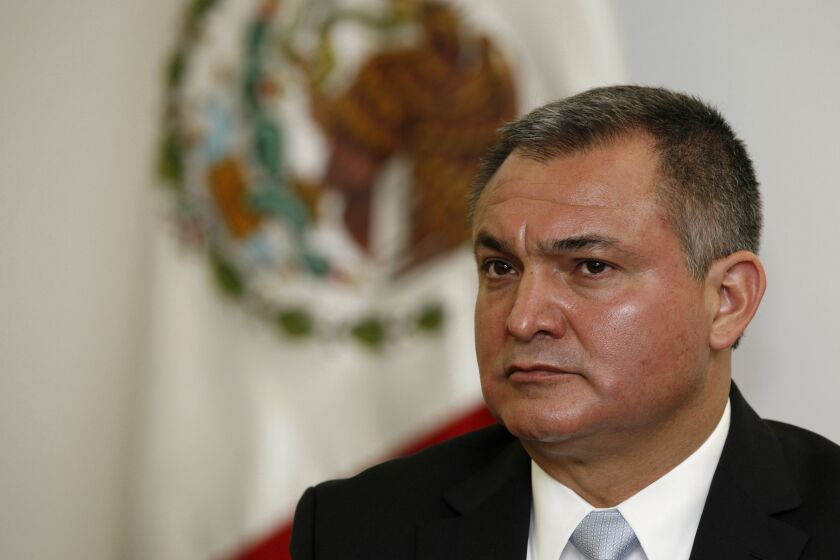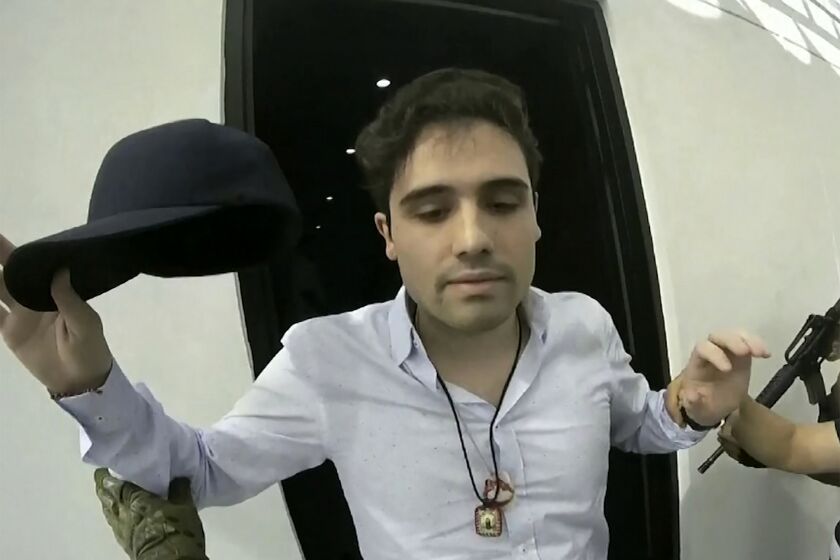García Luna is accused of accepting millions of dollars to let the notorious Sinaloa cartel operate with impunity as it sent tons of cocaine to the U.S.
“The person who’s supposed to be in charge of fighting the Sinaloa cartel was actually its most valued asset … and with his help, the cartel made millions,” Assistant U.S. Atty. Philip Pilmar told jurors. He called García Luna “a man who betrayed both his country and ours.”
 He said that while García Luna portrayed himself to both countries as a drug enforcement hero, he saw to it that the cartel got information on investigations, police escorts and smooth passage for its cocaine through police checkpoints — and sometimes even badges — for cartel members. Officers hand-delivered drug shipments from airports and acted as mercenaries to kill people whom the cartels wanted gone, Pilmar said.
He said that while García Luna portrayed himself to both countries as a drug enforcement hero, he saw to it that the cartel got information on investigations, police escorts and smooth passage for its cocaine through police checkpoints — and sometimes even badges — for cartel members. Officers hand-delivered drug shipments from airports and acted as mercenaries to kill people whom the cartels wanted gone, Pilmar said.
García Luna’s lead lawyer, César de Castro, told jurors that the government’s case rested on “rumors, speculation and the words of some of the biggest criminals in the world.”
“No money, no photos, no video, no texts, no emails, no recordings, no documents — no credible, believable evidence that Genaro García Luna helped the cartel,” the lawyer said in his opening statement. He described the case as “a very public and angry display” by a U.S. government that is forsaking a onetime drug-fighting partner whose diligent work made him enemies: corrupt police officers, politicians who opposed the anti-drug war, and cartels. Traffickers are taking the stand to lessen their own punishments and exact revenge, the attorney argued.
“Don’t let the cartels play you,” he told jurors in his opening statement.
They soon heard a different story from former police officer-turned-cartel insider Sergio Villarreal Barragan, known as “El Grande.”
He testified about joint Sinaloa-police raids on the rival Gulf cartel’s operations in the city of Monterrey; police officers letting him set up routes to move 1,700 to 2,600 pounds of cocaine multiple times a week through the state of Chiapas; and police tipping the cartel to forthcoming searches so the traffickers could clear out beforehand.
Villarreal Barragan said that after some Sinaloa cartel drugs were seized in the state of Sonora, he got the contraband released by reminding the regional police commander that the cartel had gotten him placed in his job.
During all these alleged episodes in the early 2000s, García Luna headed the federal police force — and got payoffs from the Sinaloa group, according to Villarreal Barragan. He described García Luna picking up duffel bags full of cash at a Mexico City safe house and collecting $14 million in cardboard boxes at a warehouse full of cocaine that police had seized from the Gulf gang and turned over to its Sinaloa rivals.
Cartel leaders viewed García Luna as “the best investment they had,” said Villarreal Barragan, who pleaded guilty to drug trafficking. García Luna’s lawyers haven’t yet had their turn to question him.
García Luna led Mexico’s Federal Investigation Agency from 2001 to 2005, then served as secretary of public security to then-President Felipe Calderon from 2006 to 2012.
Seen as the point man in Calderon’s bloody war on cartels, García Luna was also considered a key ally in a U.S. anti-drug-trafficking initiative that started in former President George W. Bush’s administration and provided Mexico’s police with equipment, technology and training. Photos shown in court depict García Luna with former U.S. President Obama, former Secretary of State Hillary Clinton, former Sen. John McCain and other high-ranking officials.
But García Luna also was dogged by allegations of ties to drug traffickers.
Then, during former Sinaloa kingpin Joaquin “El Chapo” Guzman’s trial in New York, a former cartel member testified in 2018 that he personally delivered at least $6 million in payoffs to García Luna, and that cartel members had agreed to pool up to $50 million to bribe him.
García Luna, who moved to Miami after leaving his government post, was arrested in 2019 in Texas and has since been held without bail in a federal lockup. He has pleaded not guilty to charges of drug trafficking and engaging in a continuing criminal enterprise. The 54-year-old could face decades in prison if convicted.
Mexican President Andrés Manuel López Obrador, a leftist, has welcomed the trial, which could spotlight corruption on a conservative predecessor’s watch.
Like Guzman, García Luna is facing jurors whose names are kept secret. They also are escorted to and from the courthouse by deputy U.S. marshals and sequestered from the public while inside.
Source: latimes


